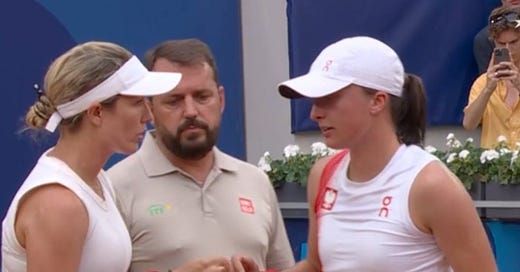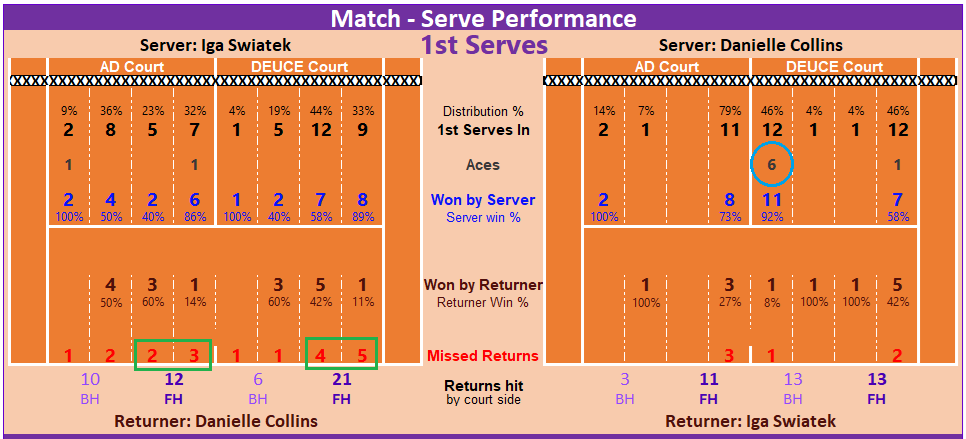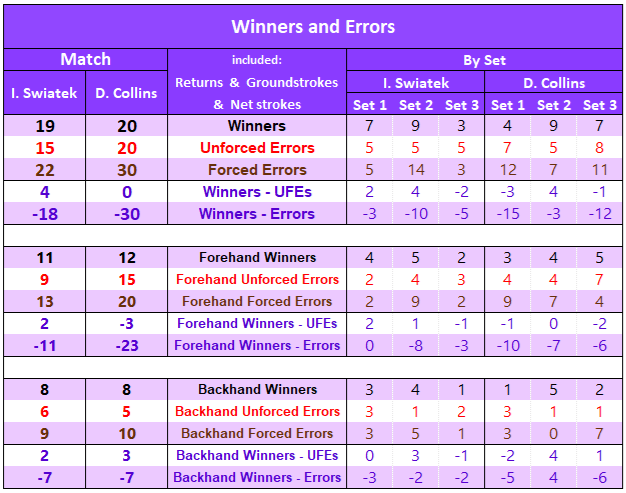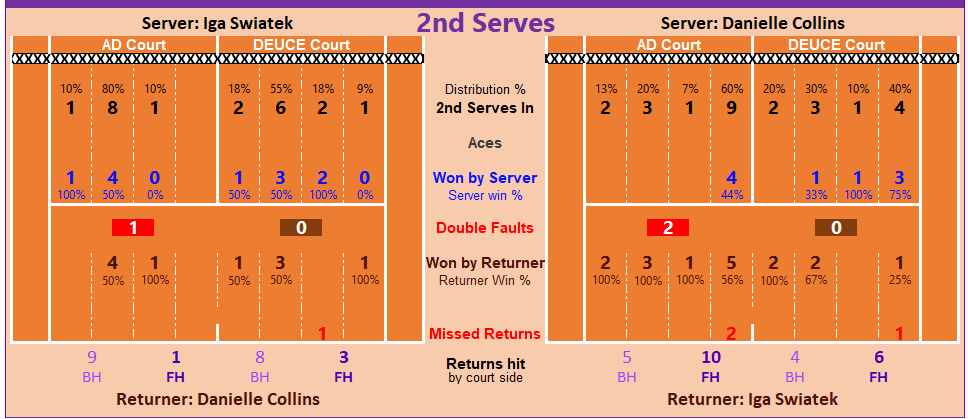Swiatek vs Collins: Paris 2024 Olympics Quarter-Final Analysis
First serves and forehands battled as Swiatek qualified for the medal rounds.
The marquee quarter-final match of the Olympics Women’s singles tennis event was the 8th career meeting between Iga Swiatek and Danielle Collins.
Both players brought their trademark intensity and desire. Collins also brought an abdominal injury.
There were subtle signs already in the first set that Collins had some kind of restriction in her movement and ball-striking. Not the ideal situation when facing Swiatek, who was seeking her 25th straight win in Paris and had a 6-1 advantage in their Head-to-Head.
After Swiatek jumped to a 3-0 lead in the third set, Collins took an off-court medical time-out. It didn’t help much. Teary-eyed during the following change-over while discussing her options with the physio, Collins opted to retire just a couple of points later.
We will discuss the following key factors:
Swiatek leaned on the serve
Forehand performances
Distinct patterns in winning groundstrokes
A tie in rallies played
1. Swiatek leaned on the serve
Breakdown of points won shows the extent of Swiatek’s free points off the serve. The world #1 extracted 19 return errors with quality deliveries and she also added 2 aces (green boxes, image below).
Swiatek’s big serving ensured she capitalized on Collins’s hit-or-miss return strategy. Collins is one of the top performers against 2nd serves but, unlike many of the game’s best returners, she can struggle against 1st serves (to read more on that I recommend this great post on Tennis Abstract).

In sets 1 and 3, Swiatek had 38% and 41% of serves that were not returned, respectively, while Collins could only match half of that (19% and 17%).
The second set saw a reversal in those numbers. Collins raised her percentage of unreturned serves to 33%, Swiatek’s dropped to 20%.
Unreturned serves per set
Set 1: Swiatek 38% / Collins 19%
Set 2: Swiatek 20% / Collins 33%
Set 3: Swiatek 41% / Collins 17%
There were some similarities in 1st serve patterns. Each player attacked the forehand return on one side of court and opted for a more even distribution on the other side.
The difference came from Swiatek serving more to the forehand on the Deuce court while Collins did it on the AD court.
In total, Swiatek extracted 14 forehand return errors from Collins (green boxes, image below).
On the other side, Collins was not as successful at extracting forehand return errors (5 in total), but she managed to win 8 of 11 (73%) AD court points serving to the forehand.
After serving wide on the Deuce court for most of set 1, Collins began using T serves as a surprise option. It worked so well that Collins delivered 5 aces on Deuce court T serves during set 2, ending the match with 6 (blue circle, image below).
2. Forehand Performances
Swiatek’s strategy of attacking Collins’s forehand return played a huge role in Collins accumulating 35 forehand errors.
From the forehand side, Collins hit 12 winners with 15 unforced errors and 20 forced errors (14 on returns). Swiatek did better, generating 11 winners while making 22 errors (9 unforced, 13 forced).
These differences in forehand performance were massive given that both players finished with the same production from the backand wing: 8 winners with 15 errors.
Forehand Performance
Swiatek: 11 winners / 22 errors = -11
Collins: 12 winners / 35 errors = -23
Backhand Performance
Swiatek: 8 winners / 15 errors = -7
Collins: 8 winners / 15 errors = -7
3. Distinct patterns in winning groundstrokes
Swiatek attacked with down-the-line drives, responsible for 11 of her 19 winning groundstrokes (blue box, image below). The majority of these were line backhands (8 in total) that targeted Collins’s forehand corner.
By contrast, Collins did more damage with crosscourt groundstrokes. In total, Collins hit 16 winning crosscourt shots with 8 unforced errors.

4. A tie in rallies played
It is rare to have a Swiatek match on clay where she doesn’t rule rallies. But that happened in this match.
Played made an equal share of the 94 rallies played, each one winning 47.
In fact, Collins was the superior baseline player. She had a 42-35 advantage in 77 points that had both players simultaneously at the baseline. Overall, Collins won 52% of her baseline points (43/83) while Swiatek could only win 46% (39/84).
Swiatek countered Collins’s baseline superiority by performing a lot better at the net. Swiatek won 8 of 10 net points (80%) while Collins was 4-for-11 (36%).
For those taking notice, both of Swiatek drop shots were drop-volleys!
2024 Olympic Games Quarter-Final - Match Data
Set-by-Set Stats
*** We have made changes to our summary tables. Please give us your feedback.
Points Won by Rally Length
Serve and Return
Winners and Errors (returns & rally shots)
Strokes Breakdown
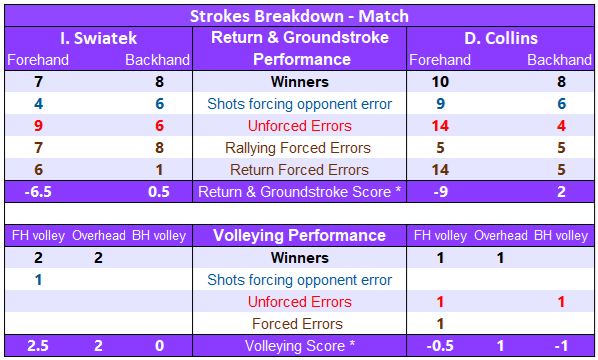
2nd Serves
Swiatek - Forehand Performance

Swiatek - Backhand Performance
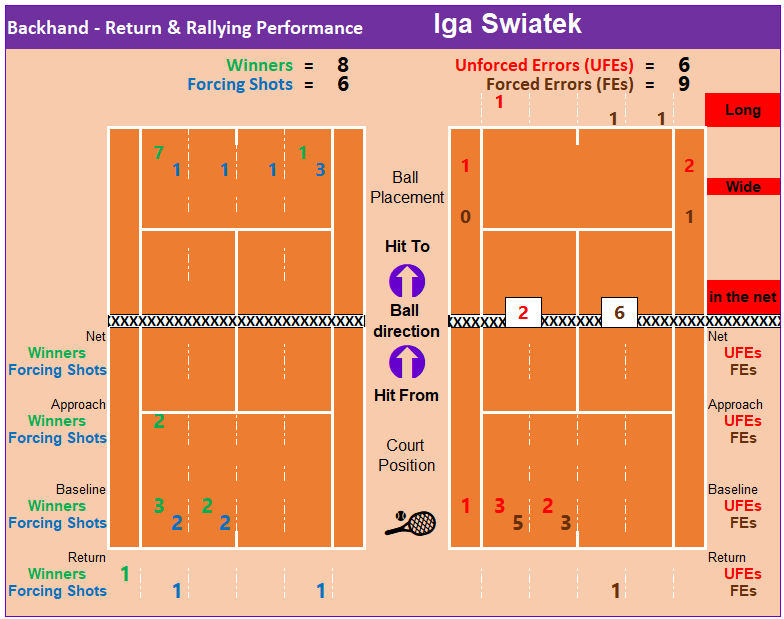
Collins - Forehand Performance

Collins - Backhand Performance

To find out more about the stats published here, please visit the following post.
*** Starting at the Olympics, we have made changes to our summary tables. Please provide us your feedback.
While we follow the same criteria used on all major tennis events, our stats are collected through our own video analysis and are not official WTA or ITF stats.
Thanks for reading!
— Tennis Inside Numbers

